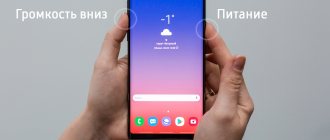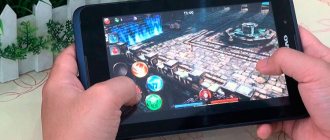Now I have two main smartphones. I tried to configure the Xiaomi Mi 9 to be similar to the iPhone Xs Max. Here's what I did:
?️Replaced the navigation buttons with gestures ?️Added a touch strip, like in the iPhone ?️Replaced the standard keyboard ?️Installed the correct theme ?️Customized the icon layout grid ?️Created an imitation cutout, like in the iPhone
You can see the result in the title picture of this post. It turned out very similar, and you can transform your Android smartphone this way too.
Let's start making an iPhone from Xiaomi:
Hiding navigation buttons and adding gestures
Xiaomi Mi 9 seems to have been created precisely to remake its interface for iOS. It just has a special “Unlimited Screen” mode, in the settings of which there is a “Full-screen gestures” switch.
With this feature, you can remove the standard navigation buttons of the operating system and add full gesture control to it.
Its principle is no different from iOS in the iPhone X and other frameless Apple smartphones.
How do I enable or disable gesture controls?
Gesture control is an excellent opportunity to increase the working area on the screen of your own smartphone. Thanks to this, you can deactivate on-screen buttons that only spoil the appearance of the mobile device shell. In this regard, many users are interested in how to enable gesture controls on Samsung or on other brands of smartphones to make controlling the gadget more comfortable, unusual and cutting-edge?
↑ Gestures on Samsung smartphones
You can immediately note that this option is not available in every phone from Samsung or Xiaomi - its presence is determined by such distinctive features as the smartphone model and firmware version. In particular, this option is present on the Samsung Galaxy M20, released in 2021.
As you know, even earlier in 2021, Samsung launched One UI to replace TouchWiz. Since then, everything looks quite colorful for Galaxy smartphone users. As a result, Android 10 moves into the era of One UI 2.0, including the latest set of gesture control components.
Since users are likely upgrading from One UI 1.0 (Android 9 Pie), they are using the traditional 3-button navigation. Android 10's gestures are largely similar to those found on the iPhone, combining full-screen navigation on every gadget with Android.
So, as for Samsung, first in “Settings” you should open the “Display” subsection and then go to the “Navigation panel”.
Then you should change the position in which the switch is located, setting the full-screen mode to “Gestures”. This is done directly from the “Navigation Button”.
The user will immediately see that the 3 navigation buttons will disappear and more space will appear on the display. With such settings, three zones will appear on the display instead of buttons - they will begin to demonstrate the limits of gestures that perform similar functions when the “ Menu”
", "
Back
" and "
Home
".
To control gestures, you need to swipe your finger straight up within the range of the required button from below (this is called swiping). This is undoubtedly not very convenient, like on Honor, but it can be used.
How can I disable gesture controls? This becomes possible by simply turning off the switch next to the “ Gesture Tips”
“—as a result, the prompts will disappear and control of gestures will be performed blindly, which is also quite easy if you remember the location of the buttons and their purpose.
Disabling the tooltips option allows you to immerse yourself more fully in the process - as a result, the whitish navigation bar will disappear at the bottom. At the same time, it is possible to activate a function that shows a button to hide the keyboard and it becomes possible to switch the keyboard at any time when using such new gestures - the keyboard symbol appears at the bottom of the screen on the right side. Otherwise, the icon will simply appear in the list of notifications if you swipe down.
Users are also interested not only in how to enable gesture controls, but also in additional settings that allow them to control specific gestures to their liking.
So, thanks to the parameter responsible for the sensitivity of the back gesture, you can adjust the normal display movement to enable the back arrow gesture. If the user has a smartphone case that is quite close to the edges of the display, then it may be necessary to increase the sensitivity in order to make it easier to swipe the edges. You should practice with sensitivity levels to find the ideal shape.
↑ Enable gestures on Xiaomi smartphones
On Xiaomi MIUI smartphones, gestures appeared in the ninth version of the shell, and in the tenth version they have more advanced functionality.
To do this, you should sequentially perform the following steps:
First, you need to go to “Phone Settings” - click on the desired icon located on the desktop, or open the curtain located at the top; then you should scroll down to the “System and Device” subsection; click on “Unlimited Screen”;
- O;
- if necessary, undergo appropriate training - this is done by clicking on the “Learn” button.
Such sequential actions allow you to activate gesture control on your Xiaomi smartphone. Their entire sequence for activating gestures is described using MIUI 10 as an example.
Users are also interested in which phones from this manufacturer have gestures available? It may be noted that this option is not available for devices that have built-in touch screen buttons
. These buttons in the models:
And this is not a complete list of models in which users have lost the gesture control function!
All newer Xiaomi devices have gesture controls! Starting with the model:
- Redmi 5
- Redmi Note 5
- Mi A2
- Mi 8
And this is not the whole list, starting with MIUI 10 and MIUI 9 (there is slightly different functionality), users can use gestures.
How to use gestures on Xiaomi smartphones, see below.
Swipe up from the bottom of the screen “Return to the desktop” (to the main screen), an alternative to the Home button. If you swipe up from the bottom with a delay (without lifting your finger from the screen), then all applications that were launched earlier will be opened. “Open applications” .An alternative to the “Back” button is by swiping from left to right or right to left. And if we swipe from left to right or right to left at the top of the screen, the menu of the open application will open to us.
From left to right or right to left without removing your finger (with a delay), we will go to the previously (previous) open application.
It is up to the smartphone user to decide whether to use the traditional type of buttons on Xiaomi or switch to gestures. At first, this option may not seem very convenient, but if you use the phone for a few days using gestures, you will see how convenient it is.
In any case, if something is not satisfactory, the user can always return to the buttons that are familiar to him.
https://androidinfo.ru/android-pomosch/658-kak-ljuchit-ili-otkljuchit-upravlenija-zhestami.html Original source of the article - © AndroidInfo.ru
Source: https://zen.yandex.ru/media/androidinfo_ru/kak-vkliuchit-ili-otkliuchit-upravleniia-jestami-5f48c0ee01237e3109d03868
Adding a navigation bar down from iPhone
To make the interface in the “Unlimited Screen” mode even more similar to iOS, I recommend trying the Gesture Control application.
Using it, you can add a special navigation bar to the bottom of the screen, which can be configured so that it is one to one, like on the iPhone.
Be sure to pay attention to which applications need to display this bar and which do not. For example, it is not needed on the home screen.
In general, the Gesture Control application is designed for flexible customization of control gestures. I'm happy with standard MIUI, but you can dig around.
Tips for users
The technology is available on all touch screen devices running on the OS: Android, Bada, MeeGo, Symbian, Windows Mobile, iOS. That is, to enter text with one touch, unlock the screen and perform other actions, you do not need to install third-party programs.
However, there are also special applications with similar functionality:
- TouchPal;
- SwiftKey;
- GBoard;
- iSwipe;
- Swype Connect.
The advantage of the utility is that the user does not need to think about the space - it is set automatically after each entered word.
Swipe is a term that refers to the principle of using a smartphone. It will take some time to get used to the continuous text input method. Then this option will seem indispensable, especially since it is also used to control the gadget.
Changing the standard keyboard to a more similar one
When using the “Unlimited Screen” function, the same Gboard (Google’s proprietary keyboard) will be located close to the bottom edge of the screen. Moreover, its rounded corners will even cut off the buttons. This is not the point.
Therefore, I recommend using an alternative SwiftKey keyboard. In its settings there is a “Size” menu, with which you can create an artificial indent where the strip from Gesture Control will fall.
Choosing suitable icons for the home screen
As standard, MIUI 10 comes with two home screen themes to choose from: “Default” and “Classic”. The icons in the latter are very similar to those used in iOS.
However, you can find a more plausible option - for example, iOS MDS 3.5 (search in the “Themes” application).
The icons in this theme match almost perfectly with iOS 12 and iOS 13. Moreover, some even have special animations that turn on when you exit the application.
We create an analogue of a special menu for widgets
MIUI has a separate side menu with widgets, but there are so few of them that there is no point in using it.
It is best to move all the icons to the second screen , make it the main one, and occupy the first with the necessary widgets. In my case, it's the weather and quick access to contacts.
So far I like this menu least of all in the entire “assembly”, so I am actively looking for third-party widgets in the Play Store.
Fix Xiaomi Gestures with Android 11
To achieve the best result in Xiaomi with these latest software versions, we must carefully focus on the optimization of MIUI 12, which we have already learned about earlier, and especially on the process that will allow us to return the default launcher to its original state. After major updates, files that are stored in the cache seem to cause problems, and in many of them it is the only thing that affects gestures.
Therefore, we will only have to go to Settings > Applications > Installed applications and find the system launcher to access the memory, clear the cache and all the data of that application. This will generally affect our content, and then we can reconfigure them on the screen to check if Android 11 gestures are working properly.
Otherwise we must install the Poco Launcher, which is available on the Play Store and which is developed in collaboration with MIUI 12, without causing any inconvenience and even being a solution that many need. There is no failure with gestures and in some ways it is better than even the native Xiaomi.
Source> Piunikaweb
Adjusting the size of the cutout in the screen for iPhone
The Xiaomi Mi 9 has a small, neat cutout that only accommodates the front camera. It's nowhere near the True Depth module for authentication security, but it does have a fingerprint sensor for that.
To make the Android device more like an iPhone, the notch needs to be made wider. The Notch Phone X app will help with this - the app works very realistically with OLED .
The only pity is that some elements will sometimes climb onto it. But this happens very rarely.











